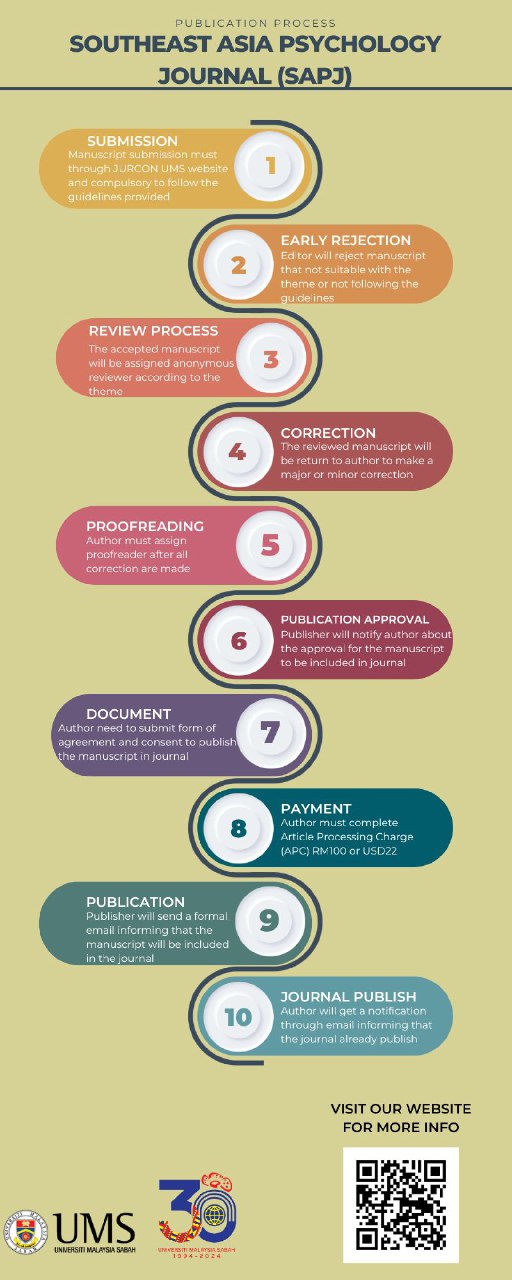EXPLORING WORKPLACE BULLYING IN MALAYSIA: RELIABILITY AND VALIDITY ANALYSIS OF THE MALAYSIAN VERSION OF THE NEGATIVE ACTS QUESTIONNAIRE REVISED (NAQ-R)
DOI:
https://doi.org/10.51200/sapj.v8i2.5128Keywords:
Workplace Bullying, NAQ-R, Malaysia, Psychometric Properties, Cross-CulturalAbstract
This is a preliminary study exploring the nature of bullying in the Malaysia workplace. Additionally, it analyses the psychometric properties of the Malaysian translation of the Negative Acts Questionnaire-Revised (NAQ-R). The sample comprised of 252 (response rate: 50.4%) employees from private and public sectors. Exploratory factor analysis indicated three components explaining 67.5% of the total variance. Confirmatory factor analysis revealed the fit indices for the modified version of Model 4, derived from the current study, showing a slightly improved model fit; 2.6, 0.87, 0.84, 0.94 and 0.08 for χ² /DF, GFI, AGFI, CFI and RMSEA. Reliability analysis showed excellent internal consistency of the scale (Cronbach’s alpha=0.96). There were significant correlations between the NAQ-R with organizational and health measures. Twenty-one percent of employees were classified as targets of workplace bullying, which was above the international prevalence (8-15%). The importance of job level and the type of contract in the bullying process were emphasized.
References
Amin, N. A., Quek, K. F., Oxley, J. A., Noah, R. M., & Nordin, R. (2015). Validity and reliability of Malay version of the job content questionnaire among public hospital female nurses In Malaysia. Int J Occup Environ Med, 6(4), 232-342. doi: 10.15171/ijoem.2015.632
Baillien, E., & De Witte, H. (2009). Why is organizational change related to workplace bullying? Role conflict and job insecurity as mediators. Economic and Industrial Democracy, 30(3), 348–371.
Bjorkqvist, K., Osterman, K., & Hjelt-Back, M. (1994) Aggression among university employees. Aggressive Behavior, 20, 173-184.
Branch, S., Ramsay, S., & Barker, M. (2007). Managers in the firing line: Contributing factors to workplace bullying by staff: An interview
study. Journal of Management & Organization, 13(3), 264–281.
Branch, S., Ramsay, S., & Barker, M. (2007). The bullied boss: A conceptual exploration of upwards bullying. In A. I. Glendon, B. M. Thompson, & B. Myors (Eds.), Advances in Organisational Psychology (pp. 93-112). Bowen Hills, Qld: Australian Academic Press.
Blunch, N. J., & Blunch, N. J. (2013). Introduction to structural equation modeling using IBM SPSS statistics and AMOS. Los Angeles, California: SAGE.
Brislin, R. W. (1970). Back-translation for cross cultural research. Journal of Cross-Cultural Psychology, 1, 185-216.
Browne, M. W., & Cudeck, R. (1993). Alternative ways of assessing model fit. In Bollen, K.A. & Long, J.S. [Eds.] Testing structural equation models. Newbury Park, CA: Sage, 136–162.
Byrne, B.M. (2001). Structural equation modeling with Amos: Basic concepts, applications and programming. Mahwah, NJ: Erlbaum.
Cook, J. D., Hepworth, S. J., Wall, T. D., & Warr, P. B. (1981). The Experience of Work. Academic Press, London.
Djurkovic, N., McCormack, D., & Casimir, G. (2008). Workplace bullying and intention to leave: The moderating effect of perceived organisational support. Human Resource Management Journal, 18(4), 405– 422.
Di Martino, V., Hoel, H., & Cooper, C. L. (2003). Preventing violence and harassment in the workplace. Bruxelles: European Foundation for the Improvement of Living and Working Conditions.







